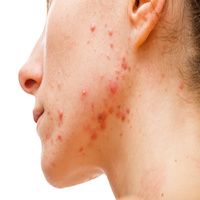Topical Azelaic Acid Effective for Treatment of Acne, Melasma, Rosacea
This analysis demonstrated the efficacy of topical azelaic acid, though further randomized control trial evidence may be needed for an evaluation of the treatment on skin aging.

For rosacea, acne, and melasma, topical azelaic acid (AA) is more effective than placebo, according to recent findings, though further randomized controlled trials may be needed to determine AA's effectiveness in improving skin aging.1
These findings were the results of a study examining the use of topical AA for rosacea, hyperpigmentation, acne, melasma, and skin aging. At present, the treatment is globally prescribed for rosacea as well as acne vulgaris, and its application extends to melasma and post-inflammatory hyperpigmentation (PIH), particularly in cases linked to acne and those with darker skin tones.2
To expand upon this background, the investigators conducted this research and the study was authored by Sarah King, PhD, from the Dermatica Institute of Clinical Excellence, London, UK.
“The objective of this systematic review was to create an up-to-date, high quality evidence base evaluating the effectiveness and safety of topical AA for acne, rosacea, melasma, hyperpigmentation, and skin aging,” King and colleagues wrote. “It is intended to inform good practice, as well as being a reference document for both patients and professionals.”
Background and Findings
The investigators used a systematic review which was egistered on PROSPERO, with the team seeking to determine both the efficacy and safety of topical AA treatments versus other interventions for skin conditions in healthy adolescents and adults in the aged group of 12 years or older.
The research team’s review was directed at outcomes including hyperpigmentation, acne, facial rosacea, melasma, and anti-aging measures, including visible improvements in wrinkles, photoaging, and dull skin. They also included studies which evaluated AA in combination with other active medications versus those medications by themselves.
Adverse events as well as serious adverse event information was assessed, encompassing local skin reactions and major reactions with grades of III or more. The investigators used a comprehensive search across several different databases, including PubMed, MEDLINE, AMED, TRIP, Embase, CINAHL, DARE, the Cochrane Library, NIHR journals, HTA databases, registries of trials, and gray literature.
The research team’s search was made not to be restricted by either language or country. Their terms for searches included ones such as 'azelaic acid,' 'Skinoren,' 'Finacea,' as well as ones connected to several different skin conditions. Two investigative reviewers screened titles independently, as well as abstracts and full papers, determining their level of relevance and executing critical appraisals through the use of RoB 2 tool for randomized control trials (RCTs).
The information the team gathered was synthesized through a meta-analysis. The quality of evidence the investigators noted for each outcome was determined through the GRADE system.
The investigators ended up with 43 RCTs that they had determined would work for the inclusion criteria in their study. In a total of 20 studies aimed at assessing rosacea, meta-analyses demonstrated that following a 12-week time frame, AA showed substantial improvements in inflammatory lesion counts, severity of erythema, overall improvements, and success of treatment compared to the vehicle.
The treatment was also shown to be more efficacious compared to metronidazole 0.75%, leading to better outcomes for severity of erythema, overall improvement, and counts of inflammatory lesions. In 16 total studies concerning acne, the investigators found that the treatment was shown to have exhibited greater effectiveness versus vehicle in enhancing global assessments as well as diminishing severity of acne.
Additionally, the investigators suggested that AA 20% showed a major reduction in lesions versus erythromycin gel. Over 7 total melasma studies, the team also found that AA 20% was considerably superior to the vehicle in relation to both global improvement and severity.
The research team also noted that AA 20% outperformed hydroquinone 2% for global improvement, and minimal notable distinctions in adverse events were noted between AA and the comparison treatments. The team did note, however, that no eligible RCTs were identified to assess skin aging.
“Where there is equivalence, AA may be a good option for some clinical situations, for example in cases where patients are not able to tolerate equivalent treatments, or where another treatment is not considered to be safe for use in pregnancy,” they wrote.
References
- King, S, Campbell, J, Rowe, R, Daly, M-L, Moncrieff, G, Maybury, C. A systematic review to evaluate the efficacy of azelaic acid in the management of acne, rosacea, melasma and skin aging. J Cosmet Dermatol. 2023; 00: 1-13. doi:10.1111/jocd.15923.
- Sarkar R, Bhalla M, Kanwar AJ. A comparative study of 20% azelaic acid cream monotherapy versus a sequential therapy in the treatment of melasma in dark-skinned patients. Dermatology (Basel, Switzerland). 2002; 205(3): 249-254.